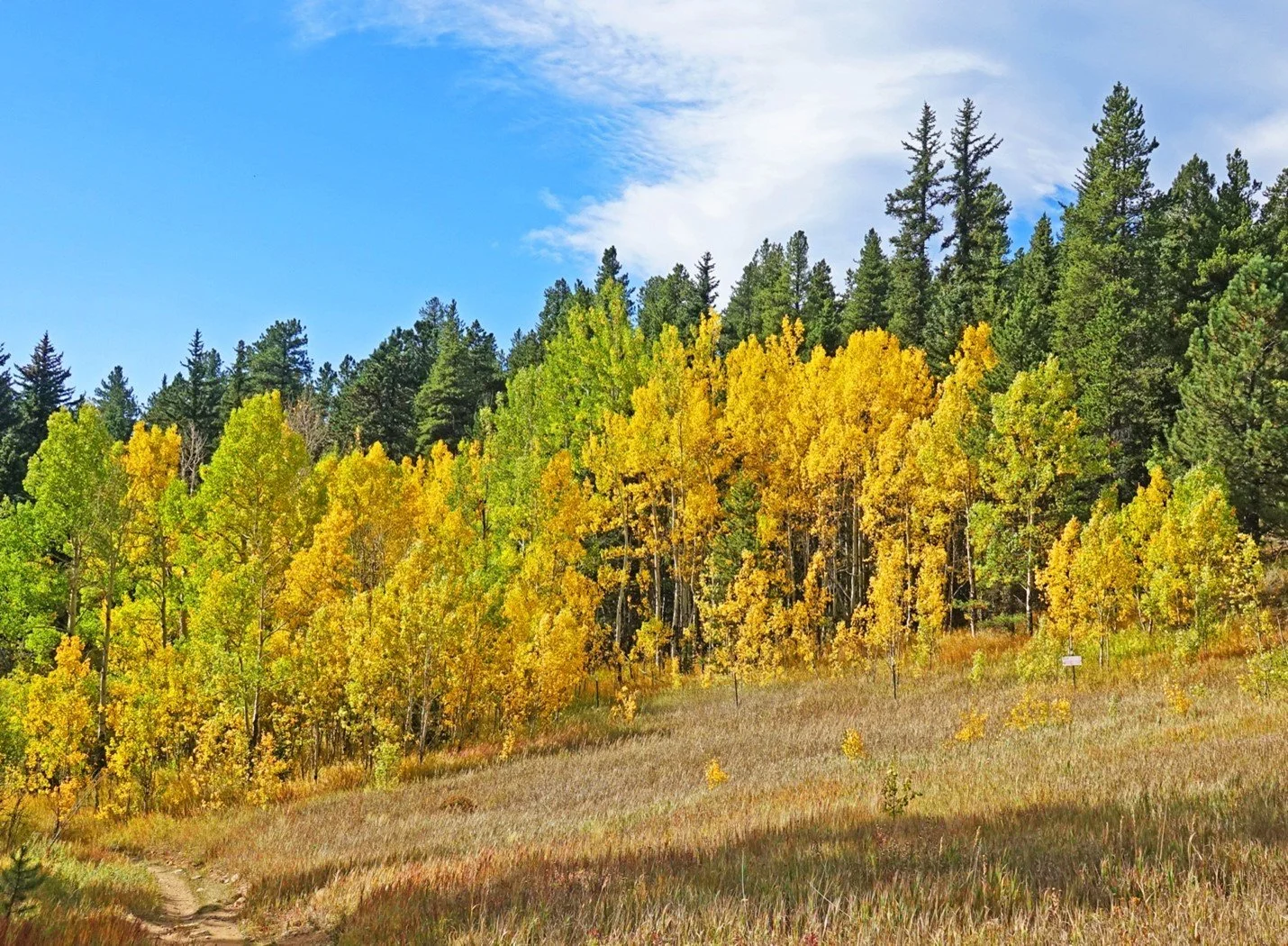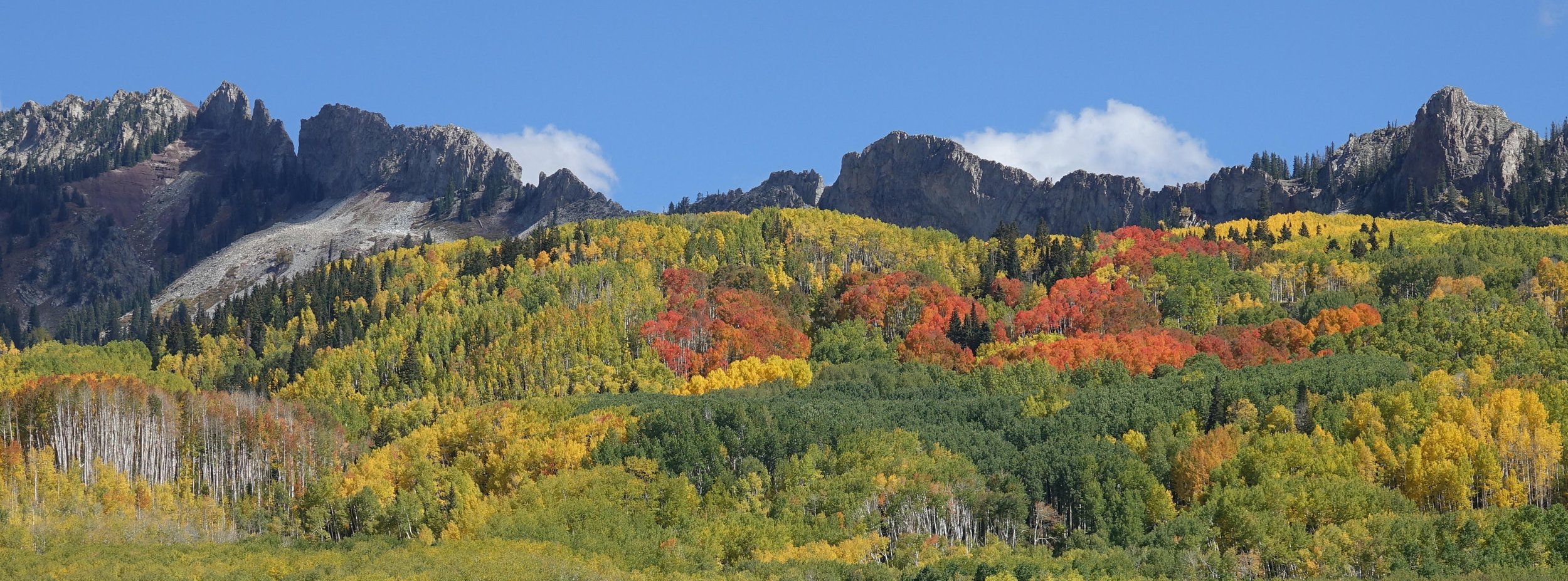September Nature Almanac: Aspen Leaves Glow and Glimmer, Whisper and—Maybe—Whimper as the World Gets Hotter
September 2024
By Ruth Carol Cushman and Stephen R. Jones
When a breeze blows, the heart-shaped leaves quiver and quake leading some Native Americans to call aspen “the tree that whispers to itself” and leading scientists to name the species Populus tremuloides. As the world gets dryer and hotter, that whisper may turn to a whimper.
Aspen have delicate heart-shaped leaves. Photo by Glenn Cushman.
We first heard of Sudden Aspen Decline (SAD) in 2007. Now, nearly two decades later, SAD is still going strong. When an aspen is stressed during the growing season, by drought and high temperatures, it may stop photosynthesizing. Eventually, it may be unable to transport nutrients and water to the crown, which may die. In addition, stressed aspen may no longer produce enough sap to push out boring beetles, leaving the trees vulnerable to the cytospora canker (learn more about aspen canker from Gilpin County Extension). When the usually white bark looks orange, the tree may be infected with this fungal disease. You can learn more about aspen and Sudden Aspen Decline on the US Forest Service website.
Boulder filmmaker Yan Chun Su has spent several years studying Pando, considered to be the world’s largest tree. Pando is an aspen clone composed of 47,000 individual trees. The original individual grew “from one seed thousands, perhaps tens of thousands of years ago, spreading over 106 acres, weighing more than 13 million pounds,” writes Yan. Pando, in Utah’s Fishlake National Forest, is one of the largest and heaviest living organisms on earth (Guinness World Records gives the title largest living organism to a patch of Posidona australis sea grass, Poseidon’s ribbon weed, growing in Shark Bay, Australia). Now, Pando—like aspen throughout the west—is in decline and not regenerating well. Yan thinks human activities, such as putting a paved road through the grove and building houses inside it, have imperiled this ancient survivor.
Aspen are also beset by over-browsing by deer and elk and by invading conifers that tend to replace aspen if not controlled by fires.
Aspen growing adjacent to conifers. Photo by Glenn Cushman.
Early in September here in Colorado, an occasional aspen tree turns into a lone golden candle. By the fourth week, entire hillsides glow in luminous tones of yellow, sometimes shading into salmon and red. While members of a clone share the same genes and flaunt the same color, they may grow next to trees cloned from a different individual. The result is multi-colored hillsides with sharp boundaries separating patches of bright green, yellow, and red.
Aspen in their many colors showing the distinct clusters of different genetic individuals across the slope of Kepler Pass. Photo by Glenn Cushman.
Aspen colors are most vivid when dry, sunny days are followed by cool nights. These conditions stimulate the growth of a corky membrane at the base of leaf stems, preventing the flow of nutrients into the leaf. As photosynthesis and chlorophyll production shut down, the green pigment fades while the yellow pigments, carotene and xanthophylls, remain. The reds are caused by anthocyanins, chemical substances in the sap with high soil acidity contributing to the reddest reds and alkaline soil leading to bluish reds.
By early October, most groves are half-bare, but individual leaves—like yellow dots of paint—create a living pointillist painting.
Here are a few places to rejoice in the glory of aspen. Check online for access points.
Peak-to-Peak Highway between Central City and Estes Park
Switzerland Trail in Roosevelt National Forest
Caribou Ranch, north of Nederland
Golden Gate Canyon State Park, west of SH 93
A stormy day can provide dramatic aspen viewing. Photo by Glenn Cushman.
Other September events
Bull elk start to bugle, to battle with rivals, and to herd cow harems.
Hawk migration peaks by the end of the month.
Ladybird beetles converge on mountaintops; young spiders “balloon” on single strands of silk; monarch butterflies head for Mexico; and other insects may move indoors for the winter.
Plums, grapes, “escaped” apples, and other wild fruits ripen, tempting black bears into the foothills.
Mule deer bucks begin to lose velvet from their antlers and engage in “play” sparring.
A partial lunar eclipse occurs on September 17, 2024 with maximum occurring at 8:44 pm in Boulder. This Harvest Moon will be the second Super full moon of the year.




